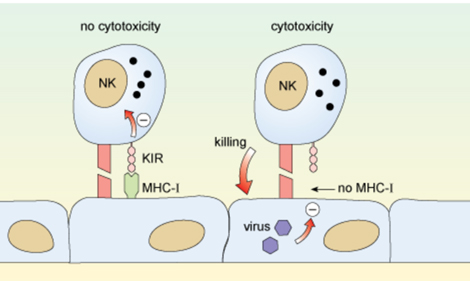1.5 Natural Killer cells
Many viruses have developed adaptations that help them to evade immune responses. A typical strategy is to prevent expression of MHC class I molecules so that viral antigens are not presented effectively to the cytotoxic T cells. However, the immune system has an alternative system for tackling this strategy – these are the Natural Killer cells, or NK cells.
NK cells are a group of lymphocytes that normally recognise MHC molecules on cells of the body, via ‘killer-inhibitory receptors’ (KIR). If the NK cell recognises MHC molecules on a cell of the body, it leaves it alone. However, if a cell has lost its MHC molecules, perhaps because it has been infected by a virus trying to escape detection, then the NK cell is no longer inhibited, and it delivers a cytotoxic signal to the target cell, as illustrated in Figure 4. The mechanisms used to induce apoptosis are similar to those deployed by cytotoxic T cells.
NK cells are normally present and active in the body and are involved in immune defence from the earliest phases of infection. They do not have the high specificity for viruses that the cytotoxic T cells have.
-
Why are cytotoxic T cells (CTLs) highly specific in their recognition of virus-infected cells?
-
Each CTL has a T cell receptor, which specifically recognises an antigenic peptide presented on a specific MHC class I molecule.
The activity of NK cells improves slightly with repeated encounters with the same antigen, but not in the way that the activity of CTLs does. As such, NK cells are normally considered to be part of the innate immune system.

